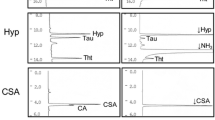Abstract
We investigated the metabolism of pectenotoxins in brown crabs (Cancer pagurus). The crabs were fed with blue mussels (Mytilus edulis) for 21 d then depurated for 42 d. We extracted the toxins from the digestive glands of contaminated crabs, uncontaminated crabs (control group), and the meat of blue mussels using methanol. Extracts of the crab digestive glands were fractionated by liquid-liquid partitioning and solid phase extraction. The fractions were analyzed by liquid chromatography coupled with tandem mass spectrometry (LC-MS/MS) and liquid chromatography coupled with ion-trap mass spectrometry (LC-MSn). We detected a new PTX-like compound, designated as metabolite-1. The MS2 mass spectrum of the metabolite-1 [M+Na]+ ion at m/z 897.5 revealed fragment ions at m/z 853.5 and 555.5, typical of those exhibited by other pectenotoxins.
Similar content being viewed by others
References
Castberg T, Torgersen T, Aasen J, Aune T, Naustvoll L J. 2004. Diarrhoetic shellfish poisoning toxins in Cancer pagurus Linnaeus, 1758 (Brachyura, Cancridae) in Norwegian waters. Sarsia, 89(5): 311–317.
Daiguji M, Satake M, James K J, Bishop A, MacKenzie L, Naoki H, Yasumoto T. 1998. Structures of new pectenotoxin analogs, pectenotoxin-2 seco acid and 7-epi-pectenotoxin-2 seco acid, isolated from a dinoflagellate and greenshell mussels. Chemistry Letters, 7: 653–654.
Draisci R, Lucentini L, Giannetti L, Boria P, Poletti R. 1996. First report of pectenotoxin-2 (PTX-2) in algae (Dinophysis fortii) related to seafood poisoning in Europe. Toxicon, 34(8): 923–935.
Fernandez M L, Reguera B, Gonzalez-Gil S, Miguez A. 2006. Pectenotoxin-2 in single-cell isolates of Dinophysis caudata and Dinophysis acuta from the Galician Rias (NW Spain). Toxicon, 48(5): 477–490.
James K J, Bishop A G, Draisci R, Palleschi L, Marchiafava C, Ferretti E, Satake M, Yasumoto T. 1999. Liquid chromatographic methods for the isolation and identification of new pectenotoxin-2 analogues from marine phytoplankton and shellfish. J. Chromatogr. A, 844(1–2): 53–65.
Larsen K, Petersen D, Wilkins A L, Samdal I A, Sandvik M, Rundberget T, Goldstone D, Arcus V, Hovgaard P, Rise F, Rehmann N O, Hess P O A, Miles C O. 2007. Clarification of the C-35 stereochemistries of Dinophysistoxin-1 and Dinophysistoxin-2 and its consequences for binding to protein phosphatase. Chem. Res. Toxicol., 20(6): 868–875.
Li Z X. 2009. Accumulation and depuration of pectenotoxins in brown crab Cancer pagurus. Chinese Journal of Oceanology and Limnology, 27(2): 389–394.
MacKenzie L, Beuzenberg V, Holland P, McNabb P, Suzuki T, Selwood A. 2005. Pectenotoxin and okadaic acid-based toxin profiles in Dinophysis acuta and Dinophysis acuminata from New Zealand. Harmful Algae, 4(1): 75–85.
MacKenzie L, Holland P, McNabb P, Beuzenberg V, Selwood A, Suzuki T. 2002. Complex toxin profiles in phytoplankton and Greenshell mussels (Perna canaliculus), revealed by LC-MS/MS analysis. Toxicon, 40(9): 1 321–1 330.
MacKenzie L, Beuzenberg V, Holland P, McNabb P, Selwood A. 2004. Solid phase adsorption toxin tracking (SPATT): a new monitoring tool that simulates the biotoxin contamination of filter feeding bivalves. Toxicon, 44(8): 901–18.
Miles C O. 2007. Pectenotoxins. In: Botana, L. M. ed., Phycotoxins: Chemistry and Biochemistry. Blackwell Publishing Ltd, Oxford. p. 159–186.
Miles C O, Wilkins A L, Hawkes A D, Jensen D J, Cooney J M, Larsen K, Petersen D, Rise F, Beuzenberg V, MacKenzie L A. 2006. Isolation and identification of a cis-C8-diol-ester of okadaic acid from Dinophysis acuta in New Zealand. Toxicon, 48(2): 195–203.
Miles C O, Wilkins A L, Munday R, Dines M H, Hawkes A D, Briggs L R, Sandvik M, Jensen D J, Cooney J M, Holland P T. 2004. Isolation of pectenotoxin-2 from Dinophysis acuta and its conversion to pectenotoxin-2 seco acid, and preliminary assessment of their acute toxicities. Toxicon, 43(1): 1–9.
Quilliam M A, Hess P, Dell’Aversano C. 2002. Recent development in the analysis of phycotoxins by liquid chromatogrphy-mass spectrometry. In: W. J. De Koe, R.A. Samson, H.P. van Egmond, J. Gilbert, M. Sabino ed., Mycotoxins and Phycotoxins in Perspective at the Turn of the Millenium Proceedings of Xth International IUPAC Symposium on mycotoxins and phycotoxins, Brasil, pp. 383–391.
Sasaki K, Wright J L, Yasumoto T. 1998. Identification and characterization of pectenotoxin (PTX-4 and PTX-7 as spiroketal stereoisomers of two previously reported pectenotoxins. J. Org. Chem., 63(8): 2 475–2 480.
Suzuki T, Beuzenberg V, MacKenzie L, Quilliam M A. 2003. Liquid chromatography-mass spectrometry of spiroketal stereoisomers of pectenotoxins and the analysis of novel pectenotoxin isomers in the toxic dinoflagellate Dinophysis acuta from New Zealand. J. Chromatogr. A, 992(1–2): 141–150.
Suzuki T, MacKenzie L, Stirling D, Adamson J. 2001. Pectenotoxin-2 seco acid: a toxin converted from pectenotoxin-2 by the New Zealand Greenshell mussel, Perna canaliculus. Toxicon, 39(4): 507–514.
Suzuki T, Mitsuya T, Matsubara H, Yamasaki M. 1998. Determination of pectenotoxin-2 after solid-phase extraction from seawater and from the dinoflagellate Dinophysis fortii by liquid chromatography with electrospray mass spectrometry and ultraviolet detection: Evidence of oxidation of pectenotoxin-2 to pectenotoxin-6 in scallops. J. Chromatogr. A, 815(1): 155–160.
Wilkins A L, Rehmann N, Torgersen T, Rundberget T, Keogh M, Petersen D, Hess P, Rise F, Miles C O. 2006. Identification of fatty acid esters of pectenotoxin-2 seco acid in blue mussels (Mytilus edulis) from Ireland. J. Agric. Food Chem., 54(15): 5 672–5 678.
Yasumoto T, Murata M, Oshima Y, Sano M, Matsumoto G K, Clardy J. 1985. Diarrhetic shellfish toxins. Tetrahedron, 41(6): 1 019–1 025.
Yasumoto T, Nagasu M, Lee J S, Torgoe K. 1989. Polyether toxins produced by dinoflagellates. In: Mycotoxins and Phycotoxins’ 88, ed. S. Natori, K. Hashimoto, and Y. A. Ueno: Elsevier. p. 375–382.
Author information
Authors and Affiliations
Corresponding author
Additional information
Supported by Norwegian International Education Funding, Quota Program
Rights and permissions
About this article
Cite this article
Li, Z. Metabolism of pectenotoxins in brown crabs Cancer pagurus fed with blue mussels Mytilus edulis . Chin. J. Ocean. Limnol. 27, 468–472 (2009). https://doi.org/10.1007/s00343-009-9147-6
Received:
Accepted:
Published:
Issue Date:
DOI: https://doi.org/10.1007/s00343-009-9147-6



